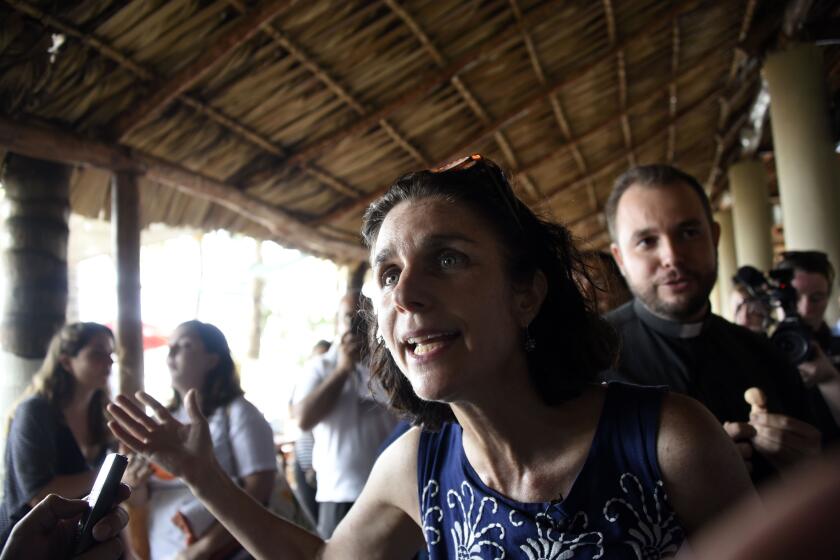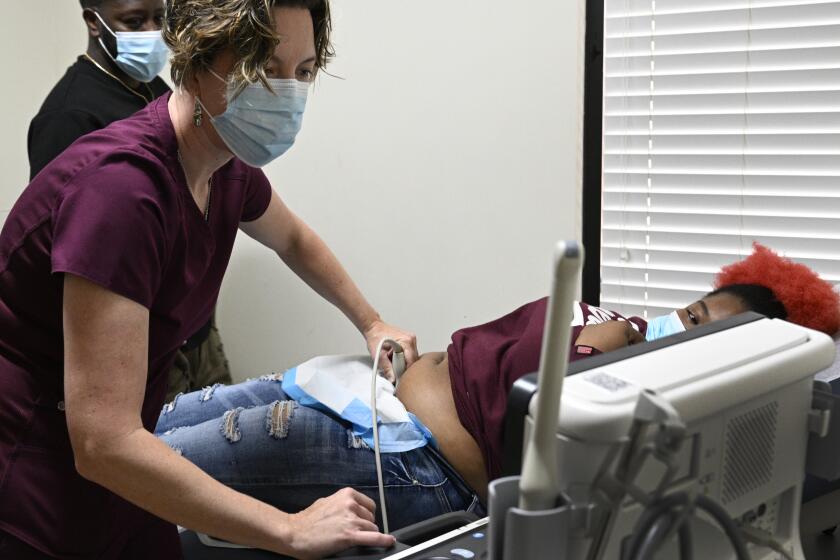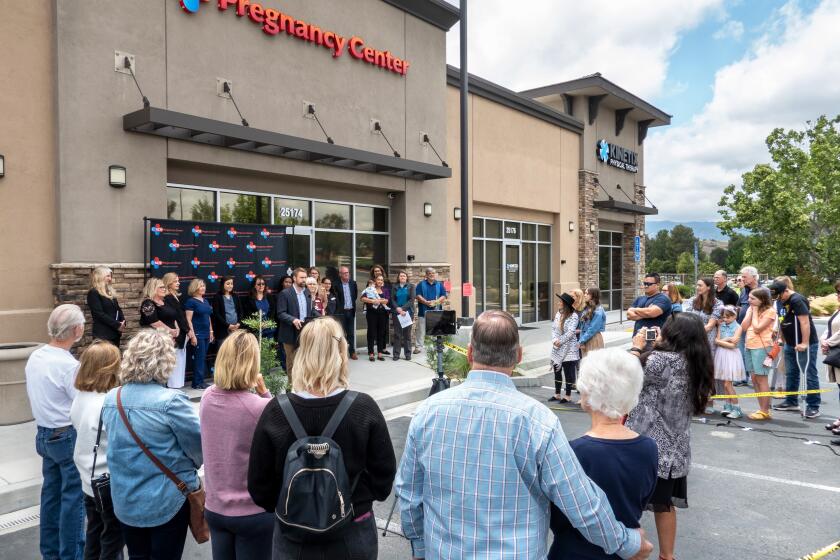‘Still in flux.’ Abortion’s uncertain future a year after Roe was overturned
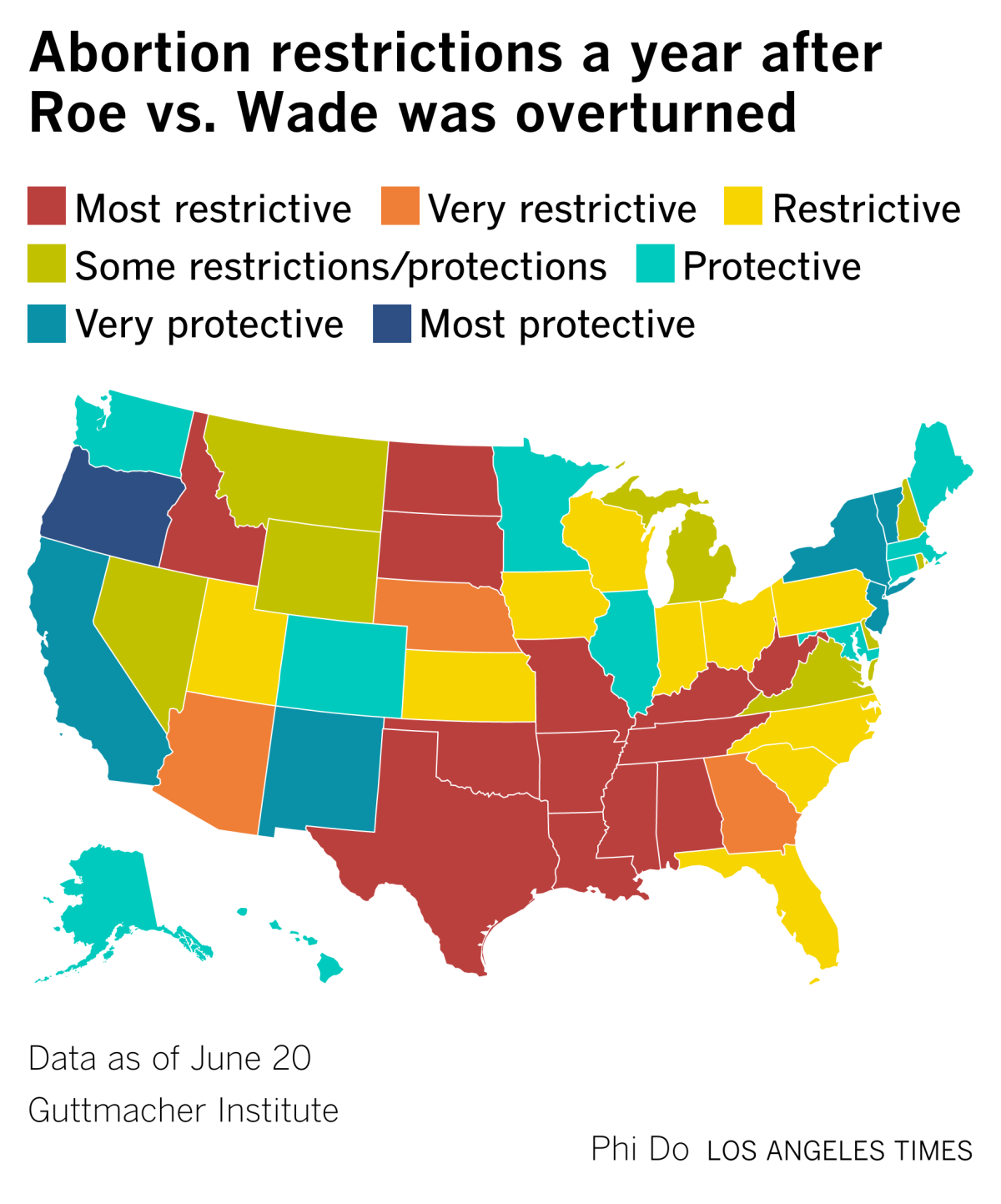
ATLANTA — A year after the Supreme Court struck down Roe vs. Wade — upending half a century of precedent on the constitutional right to an abortion — more than a quarter of U.S. women of reproductive age live in a state where the procedure is banned, severely limited or unavailable.
Since the high court’s Dobbs vs. Jackson ruling, which left abortion decisions up to the states, conservative lawmakers have introduced nearly 400 bills to restrict access — even as polling has found that 61% of Americans think abortion should be legal in all or most cases.
Abortion is banned, unavailable or sharply restricted in 15 Republican-led states across the South and Midwest. And though the procedure is legal and protected in more than 20 states, battles are being waged in courtrooms across the nation after several new restrictions have been temporarily blocked by litigation.
Many Democratic-led states, including California, have taken steps to bolster access after the Dobbs decision by adding new legal protections. At the same time, a burgeoning underground network of activists is helping to distribute abortion pills to people in conservative states so they can self-manage their abortions.
But even in blue states, reproductive rights remain in peril as antiabortion activists sue to block access to medication abortion and continue their push for a nationwide ban.
“It’s obviously a moment where a lot is still in flux,” said Mary Ziegler, a legal historian at UC Davis Law School. “As much as it seems as if this year has already been unprecedented in terms of the kinds of restrictions we’re seeing, it’s just the beginning.”
Already, about 19 million women of reproductive age live in a state that has banned abortion outright or at six weeks, according to the Guttmacher Institute, a Washington, D.C.-based nonprofit that tracks state-level abortion legislation. That number falls short of initial predictions but would climb to nearly 25 million in the coming months if Florida’s and South Carolina’s bans at six weeks — before most women know they are pregnant — go into effect.
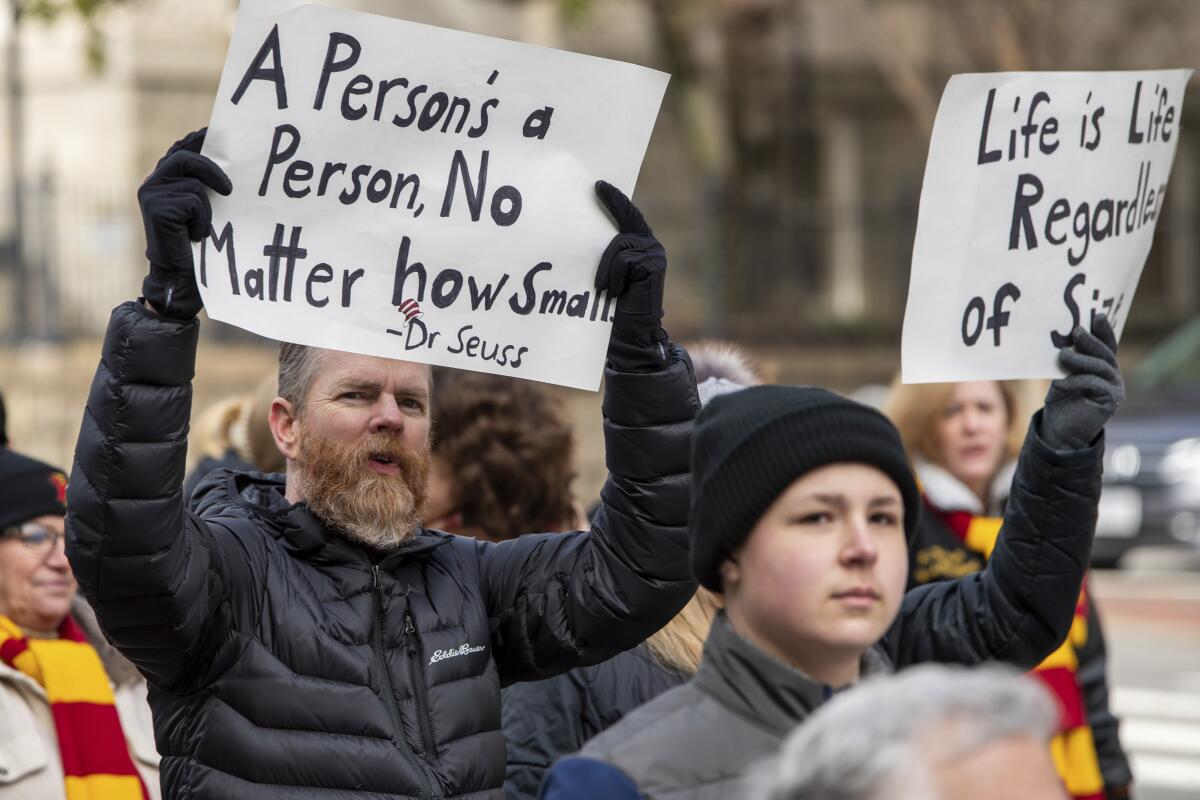
Marjorie Dannenfelser, president of Susan B. Anthony Pro-Life America, a nonprofit group that works to end abortion in the U.S. by electing antiabortion politicians, said that almost half the states passing “pretty ambitious pro-life legislation” was a “pretty good scorecard for one year.”
But Dannenfelser is not done. After playing a key role in 2016 persuading Donald Trump to commit to appointing Supreme Court justices who oppose abortion, she is working to push Republican presidential candidates to support, at the minimum, a 15-week national abortion ban.
Abortion pills: European doctor vows abortion bans or court rulings won’t stop her from getting medications to U.S. states including Texas, California.
“Otherwise they will not gain the support of the pro-life movement,” Dannenfelser said. “So you see the bright red line that we’ve drawn.
“The fall of Roe marked the beginning of the race. It’s not the end of anything,” Dannenfelser added. “This is the most motivating moment for the pro-life movement since 1973.”
A year after the Dobbs decision, the United States is no closer to reaching a consensus on abortion, and the map has become a bewildering patchwork of state restrictions and protections.
“Clearly, the Dobbs decision, far from settling the matter, has actually led to even more confusion and chaos,” said Kelly Baden, vice president for public policy at the Guttmacher Institute. “It’s a challenging landscape, and it is patients who pay the price. There are people who want to get an abortion, and they’re not sure: Is it legal in their state? Can they leave their own state?”
Activists in Poland say there are ways to work around even draconian anti-abortion measures. But there’s plenty to fear, they say.
In Florida, Planned Parenthood’s abortion clinics in Tallahassee and Jacksonville have scrambled as the number of patients flocking there for abortions has more than doubled in the last year after neighboring Deep South states banned or severely restricted abortion.
At the same time, clinics in Florida are preparing for a six-week abortion ban to come into effect in the fall, virtually eliminating the procedure in a state with one of the highest abortion rates in the nation. With conservatives dominating the Florida Supreme Court, abortion advocates are fighting to put an amendment protecting abortion on the state ballot in the 2024 election.
“The battle is not over,” said Laura Goodhue, executive director of the Florida Alliance of Planned Parenthood Affiliates. “Politicians in Florida made a gross overreach when they banned abortion at six weeks. There will really be nowhere turn in the South, unless we amend Florida’s constitution.”
Where is abortion completely banned or severely restricted?
A year after Roe, abortion is completely banned in 13 states: Alabama, Arkansas, Idaho, Kentucky, Louisiana, Mississippi, Missouri, North Dakota, Oklahoma, South Dakota, Tennessee, Texas and West Virginia.
A former abortion clinic in Alabama evolves amid bans on caring for uninsured patients and offering post-miscarriage treatment and transgender care.
In Georgia, abortion is banned at six weeks of pregnancy, although litigation continues. In Wisconsin, providers have stopped offering abortions because of legal uncertainty around the status of a pre-Roe ban.
Many bans list exceptions in the case of danger to a pregnant woman’s life or health, but abortion advocates say that in practice such restrictions can lead physicians to delay providing miscarriage management care. A recent survey by KFF, a nonpartisan health policy research group, found that 4 in 10 OB-GYNs practicing in states where abortion is banned said they personally felt constraints on their ability to provide care for miscarriages and other pregnancy-related medical emergencies since the Dobbs decision.
Where is abortion partially restricted?
Abortion is banned at 12 weeks in Nebraska and 15 in Arizona. A 15-week abortion ban is also in effect in Florida, but a six-week abortion ban signed into law in April is expected to go into effect soon, depending on a Florida Supreme Court decision.
Utah bans abortion at 18 weeks while the state’s more stringent trigger ban and a law mandating the closure of all abortion clinics across the state are temporarily blocked. North Carolina prohibits abortion after 20 weeks, but a 12-week ban will take effect July 1 following Republican legislators’ override of Democratic Gov. Roy Cooper’s veto.
Where is litigation pending?
Litigation is ongoing in 15 states as abortion rights advocates challenge state bans, according to KFF. In 10 of those states — Arizona, Florida, Georgia, Kentucky, Louisiana, Missouri, Nebraska, North Dakota, West Virginia and Wisconsin — bans are in effect. But in five — Indiana, Ohio, South Carolina, Utah and Wyoming — bans are temporarily blocked by courts.
Litigation has concluded in four states, according to KFF, with bans in effect in Oklahoma and Idaho, and bans permanently blocked in Iowa and Michigan.
Where is abortion legal and protected?
Abortion is legal and likely to be protected in 23 states — Alaska, California, Colorado, Connecticut, Delaware, Hawaii, Illinois, Kansas, Maine, Maryland, Massachusetts, Michigan, Minnesota, Nevada, New Hampshire, New Jersey, New Mexico, New York, Oregon, Pennsylvania, Rhode Island, Vermont, Washington — plus Washington, D.C.
Twenty states have taken action to protect patients and providers with “shield laws,” including in California, where voters enshrined abortion protections in the state Constitution and Gov. Gavin Newsom signed a bill to guard patients and providers from laws in other states.
Legislation aiming to regulate crisis pregnancy centers in California have failed despite otherwise robust abortion access policy.
Massachusetts, New York and Vermont passed laws that expand access to medication abortion on university and college campuses. Colorado passed bills that cracked down on antiabortion centers that use “deceptive practices” to market themselves as abortion clinics and required most health insurance plans to offer accessible coverage for abortions.
“In our region, there’s a real question of what it means from both a political, infrastructure and community perspective, to be a state where people from other states rely on you for healthcare that is essential and fundamental,” said Jack Teter, regional director of government affairs for Planned Parenthood of the Rocky Mountains, which includes Colorado, New Mexico, southern Nevada and Wyoming.
“The impact of millions of people living in states where abortion is now a felony cannot be overstated. It’s not just that you can’t find someone to provide abortion care or you want one but you can’t get one … but what it does to your psyche to live in a state where abortion care is a crime, both on the patient side and the provider side. Patients are terrified.”
What happened to abortion clinics in states that banned abortions?
In the first 100 days after Roe was overturned, 66 clinics across 15 states were forced to stop offering abortions, according to the Guttmacher Institute. Some closed completely, and others moved across borders to serve people from another state. After closing in July, the last abortion clinic in Mississippi, Jackson Women’s Health Organization, set up a new center in Las Cruces, N.M.
Others, such as the West Alabama’s Women’s Center in Tuscaloosa, Ala., stayed open even though they can no longer provide abortions, and instead offer low-income and uninsured women prenatal care, birth control, miscarriage treatment and gender-affirming care.
In the 1950s and 1960s, the LAPD’s abortion squad hunted down women getting the procedure and the people performing them.
For patients, the logistics of accessing abortion in huge stretches of the South and Midwest has gotten more burdensome. For women in rural Texas and Alabama, obtaining an abortion can mean driving or flying more than 1,000 miles to states such as New Mexico, Colorado, Illinois and Florida.
“It’s chaos,” said Alison Dreith, the director of strategic partnerships at the Midwest Access Coalition, an abortion fund that helps people traveling to secure a safe, legal abortion. “None of this is about the health and safety of people. It’s devastating.”
Her network is serving 50 more clients a month than in 2022, with the biggest influx from Texas.
After Iowa passed a six-week abortion ban last year, Dreith had put a client in an Uber to the airport to fly to her procedure when Planned Parenthood called to say it was pausing services until the decision worked its way through the court. The woman had to scramble to reschedule an abortion in Minnesota, Dreith said.
Since Dobbs, Dreith said, the hotline has heard new questions: “Where do I get pills online? How do I self-manage my abortion?”

Will access to medication abortion be halted?
Antiabortion campaigners are seeking to limit availability of mifepristone, an abortion medication used in the United States since 2000 and one of two drugs used in combination in about 54% of abortions nationwide.
Abortion pill ruling: A federal judge in Texas halts FDA’s approval of mifepristone, an abortion medication. But another judge contradicts the ruling.
In April, a federal judge in Texas ordered a hold on the Food and Drug Administration’s approval of mifepristone, which is used to end pregnancies in the first 10 weeks. That could have halted FDA approval of the medication nationwide, including in California and other states where abortion is legal. But soon after the Texas decision, a federal judge in Washington state issued a contradictory ruling — ordering the FDA not to make any changes in the availability of the abortion pill. The U.S. Supreme Court then granted emergency requests from the Biden administration and the maker of the drug to preserve access while appeals play out this year.
Meanwhile, conservative lawmakers in states including Arkansas, Florida and Wyoming have passed laws to restrict medication abortion.
Has there been any good news for abortion rights advocates?
In Kansas, the first state to vote on abortion rights after Roe was overturned, 59% of voters rejected an amendment to remove abortion protections from the state constitution.
The August 2022 victory in Kansas, where registered Republicans and unaffiliated voters outnumber Democrats, offered abortion rights advocates a blueprint for future battles. Instead of simply rallying the progressive base, activists built a broad coalition, using the language of personal freedom and constitutional rights.
In November, voters in Michigan, which had never repealed its pre-Roe abortion ban, approved a state constitutional amendment that guaranteed the right to abortion. In April, Democratic Gov. Gretchen Whitmer repealed the 1931 abortion ban.
What’s next on ballot initiatives and organizing?
In Florida, a coalition of reproductive rights and grassroots groups launched a campaign last month to amend Florida’s constitution to “limit government interference with abortion” before a fetus is considered viable. This week, they announced they’ve raised more than a quarter of the 891,589 signatures needed to get the measure on the ballot.
“The momentum around getting abortion on the ballot is palpable,” said Democratic state Rep. Anna V. Eskamani, who represents the Orlando area and used to work for Planned Parenthood. “People are just incredibly excited to be a part of something that’s proactive, versus always trying to fight back against a Republican legislature where we just don’t have the numbers to stop this type of policy.”
As abortion rights advocates push for ballot initiatives in other Republican-led states, antiabortion campaigners are raising the alarm.
“These are states that are our grounds,” Marjorie Dannenfelser said. “It’s kind of the Gettysburg of the abortion movement when the abortion lobby is coming into a place like Ohio or Nebraska or North or South Dakota, to try to change their state constitution.”
For Rachel Carmona, executive director of the Women’s March, the outcome of Dobbs is still “very unclear” to many women, including her, an activist with a master’s degree in public policy.
“Even folks whose rights have not been immediately curtailed may not know that they’re not,” said Carmona. “It’s a very confusing time to understand exactly what is true and what is not true, what’s accessible to you and not accessible to you if you’re a woman.”
More to Read
Sign up for Essential California
The most important California stories and recommendations in your inbox every morning.
You may occasionally receive promotional content from the Los Angeles Times.
